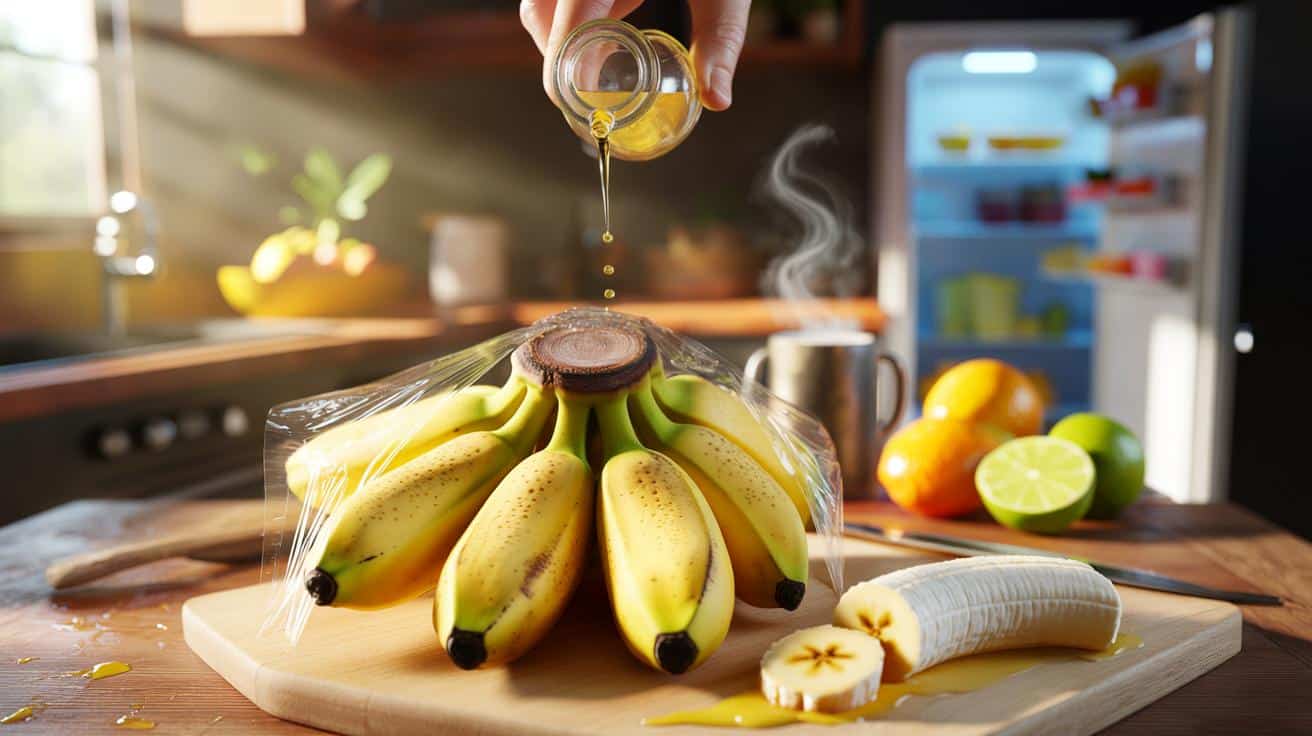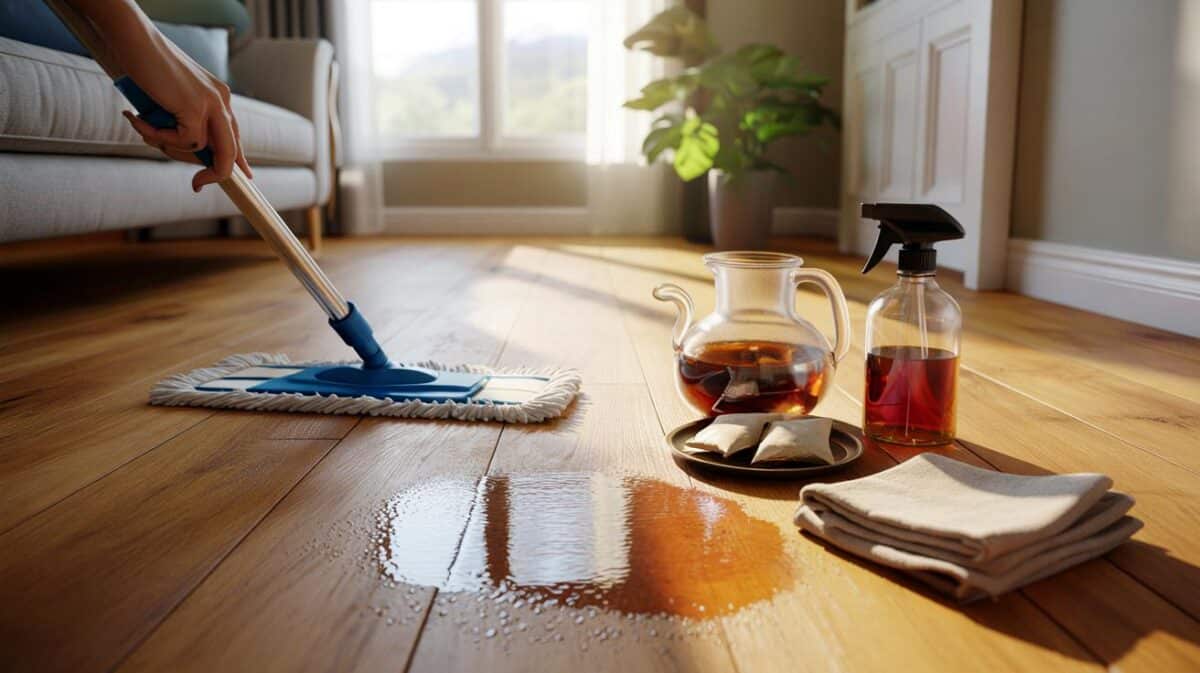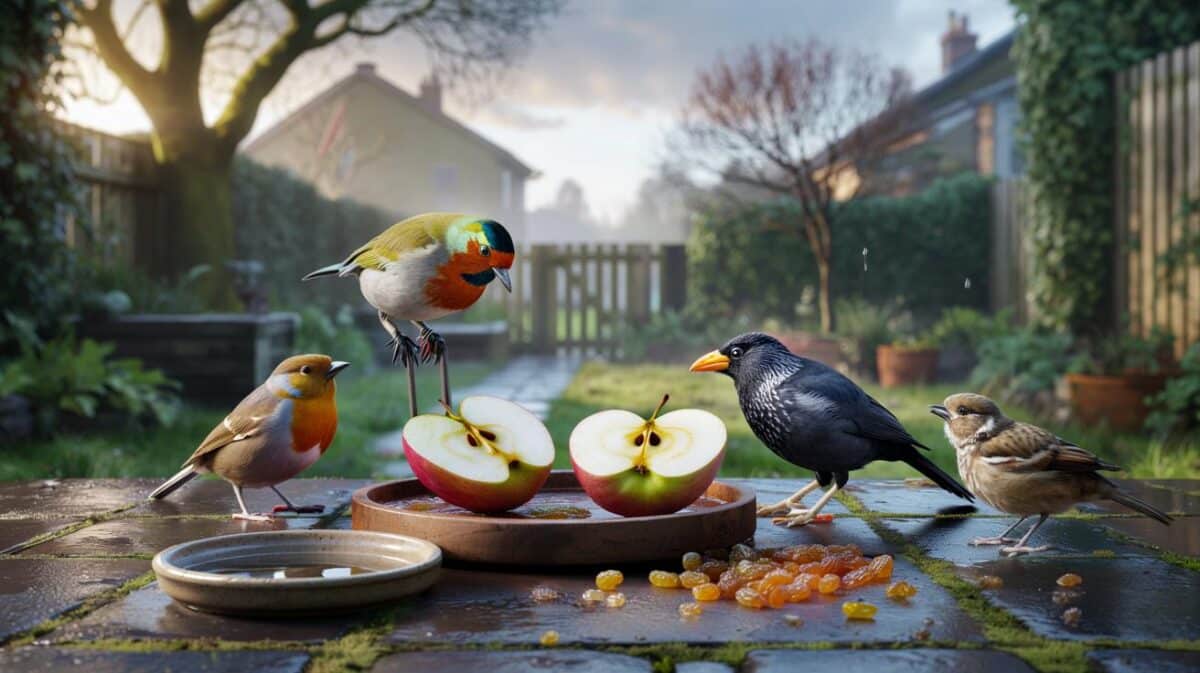Bananas turn from sunny to splotchy in a blink, then sit on the counter like a guilty secret. The fix isn’t fancy. It’s a drizzle from a bottle most of us already have next to the chopping board.
A child refuses it, a flat white steams, and you start the quiet negotiation: is it still good, or will it taste tired? You can almost hear the clock ticking on the fruit bowl. Two weeks later, in the same kitchen, the bananas are still bright and sweet inside, even if the skins have grown freckled with age. The bowl looks lived-in, not wasteful. A tiny tweak changed everything. Here’s the odd thing.
Why bananas rush to brown — and how to slow them right down
Bananas don’t just “go bad”; they’re sprinting through a natural ripening marathon powered by ethylene gas. That gas is like a megaphone telling cells, “Soften up, sweeten, change colour.” Once it kicks off, the race is on. A warm worktop only turns up the volume. The peel darkens fast, and when cut or bruised, the flesh browns as enzymes meet oxygen and get busy with pigments.
In Britain, we buy bananas by the bunch and promise ourselves smoothies. Then life happens. WRAP once estimated that the UK bins well over a million bananas a day, usually because they look “past it”. On a suburban street in Leeds, I watched a neighbour try three tricks in one week: hanging the bunch, splitting them up, and putting one by the window. The window banana lost within days. The hung bunch limped to Friday. The split stem? It lasted into next week.
Two processes are at play. Ripening is ethylene-led and speeds up in warmth or when fruit is clustered. Browning on cut surfaces is enzyme-led; polyphenol oxidase meets air and browns the flesh like a slow-burn apple. The peel’s speckles are cosmetic, a separate saga. Change the gas flow, change the oxygen, change the pH at the most active point — the crown where bananas join — and you tilt the timeline in your favour. Small intervention, big effect.
Pour this on the stems: the lemon trick that buys you weeks
The ingredient is lemon juice. Not a spritz over the whole fruit, but a targeted pour over the crown — the cluster of stems at the top. Drip a teaspoon of lemon juice onto the crown so it wets the cut edges. Let it sink in for 10–15 seconds, then pat dry and wrap the crown snugly with a small square of cling film or compostable wrap. Store the bunch at room temperature until fully yellow, then move it to the fridge. *Yes, lemon juice on the stems actually buys you time.*
A few practical notes. Use bottled or fresh; both work because it’s the acidity that matters. If you hate lemon scent, a diluted splash of lime or orange juice does the job, though it’s a touch gentler. Don’t soak the whole banana — sticky peel attracts fruit flies. Once the bananas are yellow, fridge time slows the inside beautifully for 1–2 weeks, even if the skin keeps darkening. **Inside, the fruit stays firm, sweet and pale.**
Common slip-ups are easy to dodge. People drench the bunch and skip the wrap, so the juice evaporates and the effect fades by day two. Others refrigerate while the bananas are still green, which can cause a mealy texture later. Let’s be honest: nobody tapes every single banana every day. Keep it simple — crown once, then wrap, then chill when ready. If you meal-prep, brush cut slices with lemon juice or a pinch of vitamin C powder in water and pop them in a lidded tub. **That stops the grey creep on smoothies and lunchbox slices.**
“Treat the crown like a tap: close it, cool it, and you slow the flow.”
- Pour 1 tsp lemon juice on the crown
- Pat dry, wrap crown tightly
- Ripen on counter, then refrigerate
- For slices, use a light lemon or vitamin C dip
What’s really happening — and how to make the habit stick
The lemon lowers pH around the crown, where ethylene signalling is lively and moisture can wick into micro-cuts. Acid reduces enzyme activity and nudges the local microbiome away from the kind of breakdown that speeds browning. The wrap keeps oxygen and moisture swings in check, like putting a cap on a fizzing bottle. Once you shift the bunch to the fridge, chemistry slows further; sugars linger, texture holds. **It’s not magic. It’s basic kitchen science, nudged in your favour.**
We’ve all had that moment where the fruit bowl feels like a countdown. This tiny routine steadies the week. Do it on shopping day, right on the counter. If lemon is out, a pinch of ascorbic acid (vitamin C powder) in a teaspoon of water works almost identically. Coconut oil can form a physical barrier on the crown if you prefer oil to acid, though it’s messier. Soy sauce, cola and other internet curiosities add flavour or sugar you don’t want. Stick to simple.
One more “parler vrai” note. Soyons honnêtes : personne ne fait vraiment ça tous les jours. Fold the trick into what you already do. Keep a squeezy lemon by the kettle. Wrap pre-cut crown squares in the drawer. Move the bunch to the fridge when the first banana is ready to eat. If you share a house, assign one person the “banana crown” job. It’s a 30-second ritual that saves a sulk at breakfast and keeps a smoothie bright on Thursday.
A small pour, a big shift
Bananas won’t stop time, and neither should your life try to. A teaspoon of lemon on the crown, a wrap, and a timely move to the fridge stretches the sweet spot into next week and often beyond. The peel may tell a gloomy story, but slice one open and it’s the same sunny fruit you picked, still fragrant, still lively. That tiny act also says something gentle about how we treat what we buy.
Tell a friend who’s forever wasting the last two in the bunch. Swap the hack with the person who brings fruit to the office. Try lime if you’re team margarita, orange if you like it soft, vitamin C if you love control. The kitchen’s full of quiet levers. This is one of the friendliest. And on a rushed morning, when the toast pops and the coffee hums, it feels like the fruit bowl is on your side.
| Key points | Detail | Interest for the reader |
|---|---|---|
| Lemon on the crown | Pour ~1 tsp on the stems, pat dry, then wrap tightly | Simple step with big payoff in freshness |
| Ripen, then chill | Keep at room temp until yellow, then refrigerate for 1–2+ weeks of good eating | Skin may darken but flesh stays sweet and pale |
| Backups exist | Lime/orange juice, vitamin C solution, or a light oil barrier on the crown | Flexible options using what’s already in your kitchen |
FAQ :
- Does lemon juice change the taste of whole bananas?The crown treatment doesn’t touch the flesh, so the taste stays the same. On cut slices, use a light touch to avoid a citrus note.
- How long can bananas last using this method?At room temperature you gain days; after moving to the fridge you often gain 1–2 weeks. Results vary with starting ripeness and kitchen warmth.
- Will the skins still go brown in the fridge?Yes. The peel browns while the inside stays firm and pale. Judge by feel, not by the speckles.
- Can I use vinegar instead of lemon?A mild 1:4 vinegar–water mix works in a pinch, but lemon or vitamin C are gentler and odour-free.
- What about separating bananas from the bunch?Splitting slows ethylene sharing. Combine it with the lemon-on-crown wrap for the best results on a busy week.









